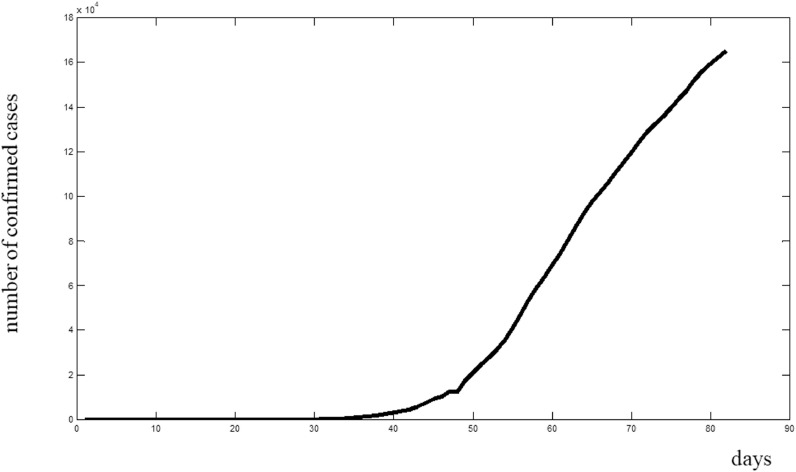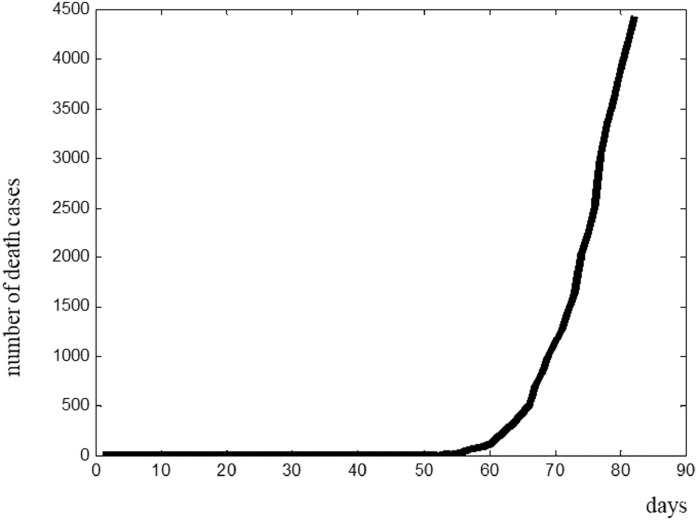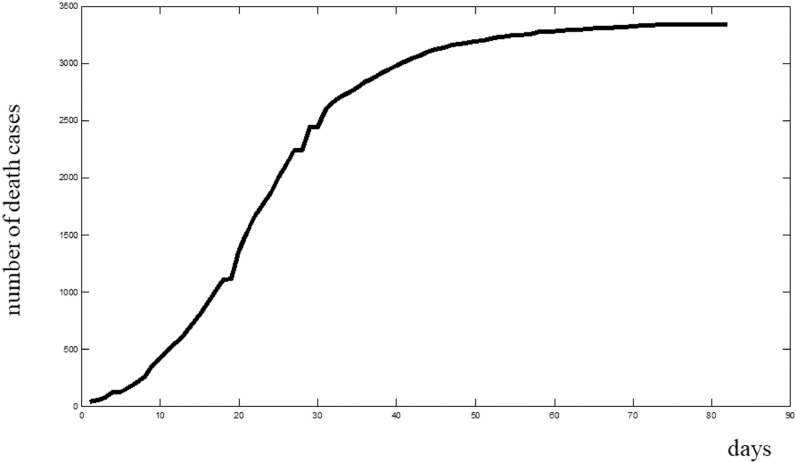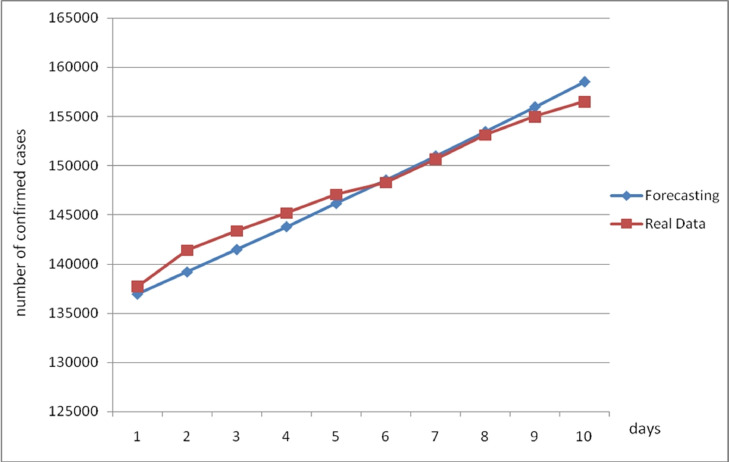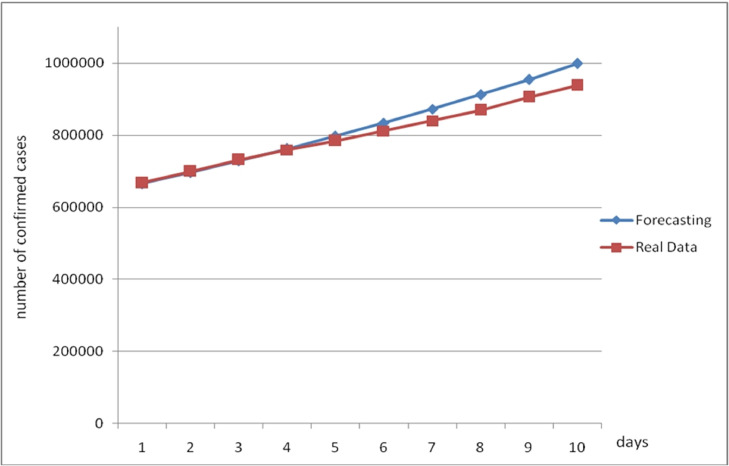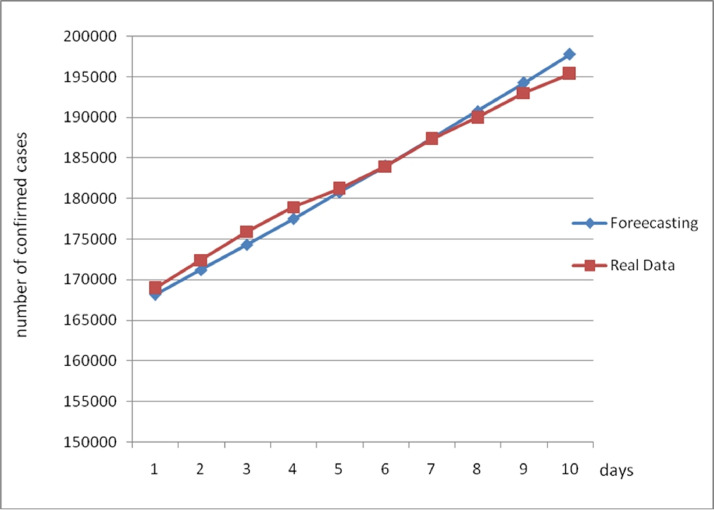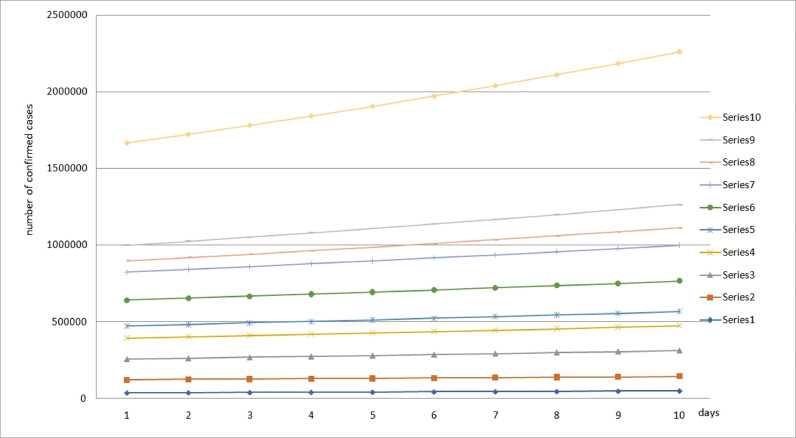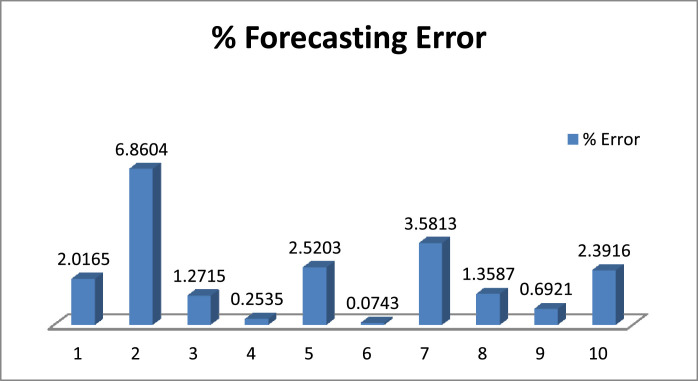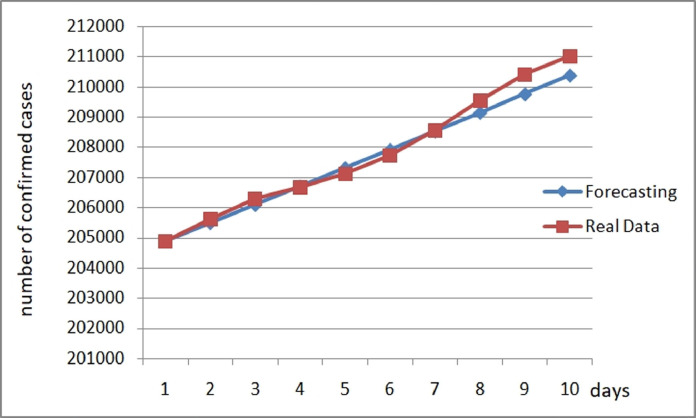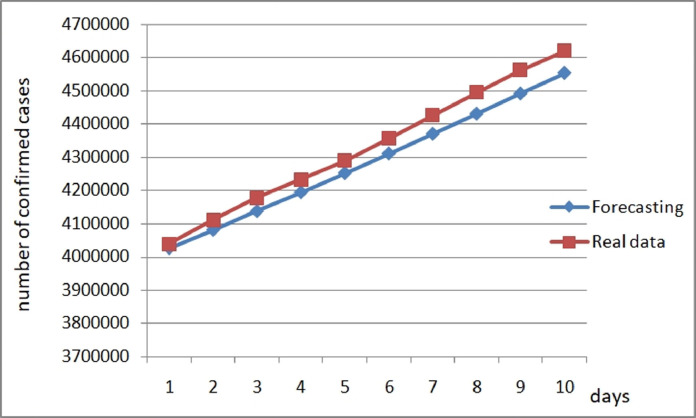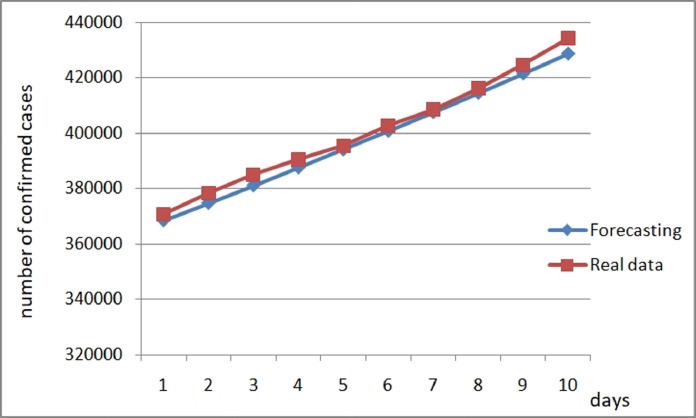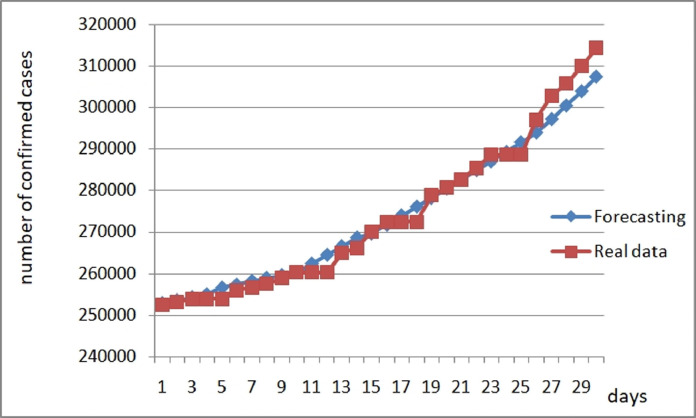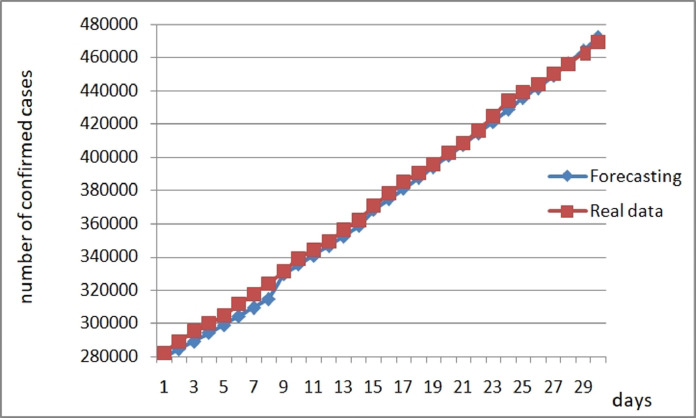Highlight
-
•
A hybrid intelligent approach for forecasting COVID-19 time series combining fractal theory and fuzzy logic is presented.
-
•
The fractal dimension is used to measure the complexity of the dynamics in the time series of the countries in the world.
-
•
Fuzzy Logic is used to represent the uncertainty in the process of making a forecast.
-
•
The hybrid approach consists on a fuzzy model formed by a set of fuzzy rules that uses as input values the linear and nonlinear fractal dimensions of the time series.
-
•
The outputs are the forecast for the countries based on the COVID-19 time series of confirmed cases and deaths.
Keywords: Fractal dimension, Fuzzy logic, Forecasting, Time series, COVID-19
Abstract
We describe in this paper a hybrid intelligent approach for forecasting COVID-19 time series combining fractal theory and fuzzy logic. The mathematical concept of the fractal dimension is used to measure the complexity of the dynamics in the time series of the countries in the world. Fuzzy Logic is used to represent the uncertainty in the process of making a forecast. The hybrid approach consists on a fuzzy model formed by a set of fuzzy rules that use as input values the linear and nonlinear fractal dimensions of the time series and as outputs the forecast for the countries based on the COVID-19 time series of confirmed cases and deaths. The main contribution is the proposed hybrid approach combining the fractal dimension and fuzzy logic for enabling an efficient and accurate forecasting of COVID-19 time series. Publicly available data sets of 10 countries in the world have been used to build the fuzzy model with time series in a fixed period. After that, other periods of time were used to verify the effectiveness of the proposed approach for the forecasted values of the 10 countries. Forecasting windows of 10 and 30 days ahead were used to test the proposed approach. Forecasting average accuracy is 98%, which can be considered good considering the complexity of the COVID problem. The proposed approach can help people in charge of decision making to fight the pandemic can use the information of a short window to decide immediate actions and also the longer window (like 30 days) can be beneficial in long term decisions.
1. Introduction
In this paper a new hybrid fuzzy-fractal approach for COVID-19 time series forecasting is presented. This new approach combines fuzzy logic with fractal theory to achieve the goal of forecasting confirmed cases and deaths for the countries based on their time series. We use the mathematical concept of the fractal dimension [1] to measure the geometrical complexity of the time series. The algorithms for estimating the fractal dimension calculate a numerical value using as input data a time series for the specific case. This numerical value gives an idea of the complexity of a particular time series. Using the numerical values for the fractal dimensions of different time series, we can build linguistic values for the dimensions and then a set of fuzzy rules that can forecast confirmed cases and death for the countries based on the behavior complexity of a time series [2]. The fuzzy rules can be obtained by performing fuzzy clustering on the data [3]. We can then apply the hybrid approach as follows. First, we need to specify the particular set of fuzzy if-then rules for the application using the fractal dimension. Then, we need to implement a method for measuring the fractal dimension (the box counting algorithm is the most popular). Finally, we use the crisp value of the fractal dimension as input to the set of fuzzy rules (along with other input variables) to perform the forecast.
The fuzzy rule base can be defined with the Mamdani inference approach, and the centroid as defuzzification method [4]. However, it is also possible to use a Sugeno type fuzzy system in which the consequents can be linear functions [5]. In this case, one possibility is to use a neuro-fuzzy approach for learning the parameters of the fuzzy system using training data of the problem. We can use, for example, the ANFIS neuro-fuzzy approach [6] to learn from real data the best values for the coefficients of the linear functions and for the membership functions [7]. We have implemented in this paper the proposed fuzzy-fractal approach for time series forecasting with the Mamdani fuzzy reasoning method.
Recently we have witnessed the quick spread of the COVID-19 around the world, beginning initially in China and then spreading to the neighboring countries in Asia, like Thailand and Korea. Later it spread to other continents, like Europe, America and Africa. In particular, in the case of Europe, Italy, Spain, France and Germany have been hit very hard with the spread of the COVID-19 virus, having many confirmed cases and deaths [8], [9], [10], [11], [12], [13]. In the case of the American continent, United States, Canada and Brazil have also been hit very hard with the spread of COVID-19 [14], [15], [16], [17]. So it is very crucial that strong research work should be undertaken for understanding all facets of this problem [18], [19], [20]. There are also some very recent works on forecasting and modeling COVID-19 dynamics in space and time [21], [22], [23], [24], [25], [26], [27], [28]. In the particular case of this paper, we are focusing on the forecasting facet of the problem, which means grouping countries according to their similarities to be able to perform a better forecast.
The main contribution of the paper is a proposed hybrid fuzzy-fractal approach for forecasting confirmed cases and deaths for the countries based on their corresponding time series. A fuzzy rule based system is proposed to express the knowledge about forecasting time series of countries. In addition, since the data is of COVID-19 around the world, we expect that our contribution will have a great impact and benefit for society.
The rest of the paper is organized as follows: Section 2 reviews the basic concepts of the fractal dimension for the benefit of the readers. Section 3 describes the basic notions of fuzzy logic for forecasting. Section 4 outlines the proposed hybrid fuzzy-fractal approach for forecasting combining the fractal dimension and fuzzy logic. Section 5 describes the simulation results of the proposed approach. Finally, Section 6 offers the conclusions and outlines possible future work.
2. Basic concepts of the fractal dimension
Recently, considerable progress has been made in understanding the complexity of an object through the application of fractal concepts [1] and dynamic scaling theory. For example, financial time series show scaled properties suggesting a fractal structure [29,30]. In addition, the fractal dimension has found applications in medicine, robotics and control. The fractal dimension of an object can be defined in the following form:
| (1) |
where N(r) is the number of required boxes to cover an object and r is a measure of the size of the box. The fractal dimension can be estimated by counting the number of boxes needed to cover the boundary of the object for different r sizes and then applying a logarithmic regression to obtain the d value (this is known as box counting algorithm). In Fig. 1 , we illustrate the box counting algorithm for a hypothetical curve C. Counting the number of boxes for different sizes of r and performing a logarithmic linear regression, we can estimate the box dimension of a geometrical object with the following equation:
| (2) |
where d is the fractal dimension, and we can use a least squares method to estimate this value.
Fig. 1.
Box counting algorithm for an arbitrary curve.
The concept of the fractal dimension provides a way to characterize and classify an object. The main reason for this statement is that the fractal dimension measures in some form the geometrical complexity of the objects. In particular, a time series can be classified based on the numeric value of the fractal dimension. The reasoning behind this fractal classification scheme is that when the boundary is smooth then the fractal dimension of the object will be close to a value of one. On the other hand, when the boundary is rougher the fractal dimension will be closer to a value of two.
3. Basic concepts of fuzzy logic for forecasting
We can use a fuzzy rule base as a forecasting scheme, if we are able to make a suitable partition of the input space, in this case of the time series, such that we are able to distinguish different geometrical objects by their characteristics. For simplicity we assume that the geometrical objects are on the plane, which in this case are patterns of a time series. In this situation we can start by using fuzzy clustering techniques [3,31,32] to group the data, and then after that construct a fuzzy rule base that will form a forecasting scheme for the specific application.
We assume that we have n objects O1, O2, …, On, and that fuzzy clustering techniques can be applied to obtain n pairs (Xi, Yi) i = 1, …, n, which can be assigned to the corresponding centers of the n clusters. Then a fuzzy rule base can be easily defined as follows:
| (3) |
These fuzzy rules can be applied to pattern classification or time series prediction because in both cases the data has similar structure. In cases with higher dimensionality, this approach can be generalized in a straightforward manner. However, the main problem is that the number of rules increases exponentially. For completing the fuzzy system in (3) we need to define the membership functions for linguistic values of the X and Y linguistic variables, and find their appropriate parameter values.
4. Proposed hybrid approach with fractal theory and fuzzy logic
In this section we deal with the problem of time series analysis and prediction. Let y1, y2, …, yn be an arbitrary time series. If the main goal is to predict this time series, we first need to perform data analysis to find the trends and periodicities of the series. Now we can assume that the clustering of the time series produces n objects O1, O2, …, On, and a fuzzy rule base can be defined as in Section 3 of this paper. However, we can now consider the geometrical complexity of the objects O1, O2, …, On as measured by their fractal dimensions, linear is dim1 and non-linear dim2, with linguistic values x1, x2, …, xn, and y1, y2,…, yn, respectively. The two versions of the fractal dimension (linear and non-linear differ in the method used to fit the data) produce different numeric values to the dimension and we decided to perform the forecasting with the two versions to improve the accuracy. Then, in a general form, the fuzzy rule base for time series forecasting can be expressed in the following way.
| (4) |
In this case, we need to define membership functions for the two versions of the fractal dimension, and for the geometrical objects. The fuzzy rule base of Eq. (4) can be used with Mamdani inference, and centroid defuzzification. For the case of forecasting in the countries based on the COVID-19 data, we did considered two time series of interest: confirmed cases and death cases. The reason is that both time series provide very important information about the problem. So at the end, we constructed a fuzzy system with a structure of four inputs and one output. The four inputs are for the linear fractal dimension of confirmed cases (LFDC), nonlinear fractal dimension of confirmed cases (NLFDC), linear fractal dimension of death cases (LFDD), and nonlinear fractal dimension of death cases (NLFDD). Two linguistic (fuzzy) values are used: low and high, to represent low and high values of the dimensions. The output variable is the Increment on the Forecast of the Country (ΔP) with three linguistic values denoting our view that countries can have an increment of forecast with three degrees of COVID-19 level: High, Medium and Low. The complete method is illustrated in Fig. 2 , where we can note that two input time series are entering the fractal dimension module, which calculates de values of the LFDC, NLFDC, LFDD, and NLFDD dimensions. Then these fractal dimension values are the inputs to the fuzzy system prediction module, where the output is the increment on the prediction ΔP. Finally, this increment is added to the previous value in the Adder Module to obtain the prediction of the next value of the time series, which we denote as Pn+1.
Fig. 2.
Structure of the proposed method for fuzzy fractal time series forecasting.
The fuzzy rules were defined experimentally based on the historical data and corresponding calculated fractal dimensions. The structure of the hybrid fuzzy fractal model is represented in Fig. 3 . The fuzzy rules to perform the classification are presented in Fig. 4 . The output membership functions are illustrated in Fig. 5 , which are one triangular and two trapezoidal functions. We show in Fig. 6 the membership functions of one of the input linguistic (fuzzy) variables. In this Figure we have two Gaussian membership functions for the values low and high, respectively.
Fig. 3.
Structure of the fuzzy fractal model for forecasting the Countries based on COVID-19 data.
Fig. 4.
Fuzzy rules expressing the forecasting knowledge in the fuzzy model.
Fig. 5.
Output membership functions of the forecasting fuzzy system of the Countries.
Fig. 6.
Input membership functions for the LFDD linguistic variable.
5. Simulation results
The proposed method based on fuzzy logic and the fractal dimension was used to express the knowledge of forecasting the times series of countries in the world and combined with the fractal mathematical models that measure the complexity of the time series, according to the number of Coronavirus cases.
The Data base used for the experiments was obtained from the Humanitarian Data Exchange (HDX) [8], which includes data from the countries where COVID-19 cases have occurred from January 22, 2020 to March 31, 2020. The consulted datasets were the following: time_series_covid19_confirmed_global, time_series_covid19_recovered_global, and time_series_covid19_deaths_global. The data includes the confirmed, recovered and deaths cases for countries, respectively. As an example, in Fig. 7 we show a plot of the trend in the time series for Belgium, clearly indicating the classes for the Covid-19 Confirmed cases for the 22–01–2020 to 31–03–2020 period of time. In Fig. 8 we show a similar plot for Italy.
Fig. 7.
Plot of confirmed cases for Belgium.
Fig. 8.
Plot of confirmed cases for Italy.
In Fig. 9 we show a plot of the trend in the time series for Belgium, clearly indicating the classes for the Covid-19 death cases for the 22–01–2020 to 31–03–2020 period of time. In Fig. 10 we show a similar plot for China.
Fig. 9.
Plot of death cases for Belgium.
Fig. 10.
Plot of death cases for China.
Based on the time series of the countries from the previous Figures, we calculate the fractal dimension values that are presented in a summarized form in Table 1 . We also show the increment produced as the output by the fuzzy system (last row).
Table 1.
Fractal dimensions of countries based on their time series and increment by fuzzy system.
| Metric | Fractal dimension country confirmed cases |
|||||||||
|---|---|---|---|---|---|---|---|---|---|---|
| Belgium | China | France | Germany | Iran | Italy | Spain | Turkey | UK | US | |
| LFDC | 1.1860 | 1.2210 | 1.1900 | 1.2020 | 1.1910 | 1.1940 | 1.1860 | 1.2040 | 1.2070 | 1.2040 |
| NLFDC | 1.7480 | 1.7240 | 1.7440 | 1.6150 | 1.7210 | 1.7220 | 1.7750 | 1.6080 | 1.624 | 1.5930 |
| LFDD | 1.2080 | 1.2120 | 1.1900 | 1.1780 | 1.2040 | 1.1890 | 1.1810 | 1.2020 | 1.2120 | 1.1870 |
| NLFDD | 1.6040 | 1.7190 | 1.7880 | 1.7100 | 1.6230 | 1.6140 | 1.7890 | 1.5960 | 1.6010 | 1.804 |
| INCR | 0.0363 | 0.0130 | 0.0242 | 0.0163 | 0.0217 | 0.0182 | 0.0280 | 0.0488 | 0.0435 | 0.0460 |
LFDC = box counting linear logarithmic fractal dimension confirmed cases, NLFDC = box counting Nonlinear logarithmic fractal dimension confirmed cases, LFDD = box counting linear logarithmic fractal dimension death cases, NLFDD = box counting Nonlinear logarithmic fractal dimension death cases, INCR = increment.
5.1. Forecasting results of an initial stage of the pandemic
In the following Figures we show plots of forecasting with the fuzzy fractal approach for several countries. We are forecasting 10 days ahead (04/16/2020 to 04/25/2020) based on data used for designing the fuzzy model (01/22/2020 to 04/152,020). Fig. 11 illustrates the forecast of confirmed cases for Belgium, where we can appreciate that the forecasted values are very close to the real values. Fig. 12 shows in a similar way the forecast of confirmed cases for Germany.
Fig. 11.
Forecasting the confirmed cases of Covid-19 in Belgium.
Fig. 12.
Forecasting the confirmed cases of Covid-19 in Germany.
Fig. 13 illustrates the forecast of the confirmed cases for the United States of America. Finally, we also show in Fig. 14, Fig. 15 the forecasts of confirmed cases for Spain and Italy, respectively. In all cases, the forecast are close to the real values, which confirms that the fuzzy fractal approach works well in time series prediction.
Fig. 13.
Forecasting the confirmed cases of Covid-19 in United States.
Fig. 14.
Forecasting the confirmed cases of Covid-19 in Spain.
Fig. 15.
Forecasting the confirmed cases of Covid-19 in Italy.
In Table 2 we show the forecasted values for the 10 countries using fuzzy fractal model, which are also shown in Fig. 16 . The data used for the model are the Confirmed cases of Covid-19 from January 22 of 2020 to April 15 of 2020. The forecasting values of the confirmed cases using the fuzzy fractal approach are for 10 days from April 16 of 2020 to April 25 of 2020.
Table 2.
Summary of forecasted values for 10 days ahead for the countries using the fuzzy fractal approach (April 16 of 2020 to April 25 of 2020).
| Forecasting values of confirmed cases using fuzzy fractal approach | |||||||||
|---|---|---|---|---|---|---|---|---|---|
| Belgium | China | France | Germany | Iran | Italy | Spain | Turkey | UK | US |
| 34,791 | 84,439 | 137,849 | 136,957 | 78,046 | 168,160 | 182,626. | 72,778 | 103,811 | 665,653 |
| 36,054 | 85,537 | 141,196 | 139,198 | 79,740 | 171,221 | 187,749 | 76,329 | 108,328 | 696,307 |
| 37,363 | 86,649 | 144,624 | 141,475 | 81,470 | 174,337 | 193,015 | 80,054 | 113,041 | 728,372 |
| 38,719 | 87,775 | 148,136 | 143,790 | 83,238 | 177,510 | 198,430 | 83,961 | 117,960 | 761,913 |
| 40,125 | 88,916 | 151,733 | 146,142 | 85,044 | 180,741 | 203,996 | 88,058 | 123,092 | 796,999 |
| 41,581 | 90,072 | 155,417 | 148,533 | 86,890 | 184,030 | 209,718 | 92,356 | 128,448 | 833,701 |
| 43,091 | 91,243 | 159,190 | 150,963 | 88,775 | 187,380 | 215,600 | 96,863 | 134,037 | 872,093 |
| 44,655 | 92,429 | 163,055 | 153,433 | 90,702 | 190,790 | 221,648 | 101,589 | 139,869 | 912,253 |
| 46,276 | 93,631 | 167,014 | 155,943 | 92,670 | 194,262 | 227,865 | 106,547 | 145,954 | 954,262 |
| 47,956 | 94,848 | 171,070 | 158,494 | 94,681 | 197,798 | 234,257 | 111,747 | 152,305 | 998,206 |
Fig. 16.
Forecasting Confirmed cases of Covid-19 in 10 countries, 1 Belgium, 2 China, 3 France, 4 Germany, 5 Iran, 6 Italy, 7 Spain, 8 Turkey, 9 United Kingdom, 10 United States (April 16 of 2020 to April 25 of 2020).
In Fig. 16 we illustrate the forecast for the 10 countries based on the time series data, where we can appreciate the difference in the number of confirmed cases.
Finally, we show in Fig. 17 a comparison of the forecasting errors for the 10 countries in this work, where we can appreciate that all the errors are relatively low and accuracy on average is of 98%.
Fig. 17.
Forecasting errors in 10 countries, 1 Belgium, 2 China, 3 France, 4 Germany, 5 Iran, 6 Italy, 7 Spain, 8 Turkey, 9 United Kingdom, 10 United States.
5.2. Forecasting results of a more recent stage of the pandemic
In the following Figures we show plots of forecasting with the fuzzy fractal approach for several countries for a more recent period. We are forecasting 10 days ahead (07/22/2020 to 08/01/2020) based on data used for designing the fuzzy model (01/22/2020 to 04/152,020). Fig. 18 illustrates the forecast of confirmed cases for Belgium, where we can appreciate that the forecasted values are very close to the real values. Fig. 19 shows in a similar way the forecast of confirmed cases for France. Fig. 20 illustrates the forecast of the confirmed cases for Germany. Fig. 21 illustrates the forecast of the confirmed cases for Italy. Finally, we also show in Figs. 22 , Fig. 23, Fig. 24 the forecasts of confirmed cases for Spain, USA and Mexico, respectively. In all cases, the forecast are close to the real values, which confirms that the fuzzy fractal approach works well in time series prediction.
Fig. 18.
Forecasting the confirmed cases of Belgium from 22 Jul to 1 August.
Fig. 19.
Forecasting France confirmed cases from 22 Jul to 1 August.
Fig. 20.
Forecasting Germany confirmed cases from 22 Jul to 1 August.
Fig. 21.
Forecasting Italy confirmed cases from 22 Jul to 1 August.
Fig. 22.
Forecasting Spain confirmed cases from 22 July to 1 August.
Fig. 23.
Forecasting United States from 22 July to 1 August.
Fig. 24.
Forecasting the confirmed cases of Covid-19 in Mexico from 22 July to 1 August.
In Table 3 we show the forecasted values for the 10 countries using fuzzy fractal model. The data used for the model are the Confirmed cases of Covid-19 from January 22 of 2020 to April 15 of 2020. The forecasting values of the confirmed cases using the fuzzy fractal approach are for 10 days from July 22 of 2020 to August 1 of 2020.
Table 3.
Summary of forecasted values for 10 days ahead for the countries using the fuzzy fractal approach (July 22 of 2020 to August 1 of 2020).
| Forecasting values of confirmed cases using fuzzy fractal approach form 22 July to 1 August | |||||||||
|---|---|---|---|---|---|---|---|---|---|
| Belgium | France | Germany | Iran | Italy | Mexico | Spain | Turkey | UK | US |
| 65,049 | 205,386 | 204,877 | 283,061 | 245,321 | 368,418 | 269,652 | 223,324 | 297,666 | 4,024,968 |
| 65,474 | 206,134 | 205,480 | 284,720 | 245,612 | 374,668 | 271,770 | 224,250 | 298,961 | 4,080,573 |
| 65,902 | 206,885 | 206,085 | 286,388 | 245,902 | 381,023 | 273,904 | 225,181 | 300,262 | 4,136,946 |
| 66,332 | 207,638 | 206,692 | 288,066 | 246,193 | 387,486 | 276,055 | 226,115 | 301,568 | 4,194,098 |
| 66,766 | 208,394 | 207,301 | 289,754 | 246,484 | 394,058 | 278,224 | 227,053 | 302,881 | 4,252,039 |
| 67,202 | 209,153 | 207,911 | 291,451 | 246,776 | 400,742 | 280,409 | 227,994 | 304,198 | 4,310,781 |
| 67,641 | 209,915 | 208,524 | 293,159 | 247,068 | 407,540 | 282,611 | 228,940 | 305,522 | 4,370,335 |
| 68,083 | 210,679 | 209,138 | 294,877 | 247,360 | 414,452 | 284,831 | 229,890 | 306,851 | 4,430,711 |
| 68,528 | 211,447 | 209,754 | 296,604 | 247,653 | 421,482 | 287,068 | 230,843 | 308,186 | 4,491,921 |
| 68,976 | 212,217 | 210,371 | 298,342 | 247,946 | 428,631 | 289,322 | 231,801 | 309,527 | 4,553,977 |
| 69,426 | 212,990 | 210,991 | 300,090 | 248,239 | 435,902 | 291,595 | 232,762 | 310,874 | 4,616,890 |
Finally, we show in Fig. 25 a comparison of the forecasting errors for the 10 countries in this work, where we can appreciate that all the errors are relatively low and accuracy on average is of 99%.
Fig. 25.
Forecasting errors in 10 countries: 1) Belgium, 2) France, 3) Germany, 4) Iran, 5) Italy, 6) Mexico, 7) Spain, 8) Turkey, 9) United Kingdom, 10) United States for the period of July 22 to 1 August 2020.
5.3. Forecasting results of the pandemic for a wider window
In the previous Sections, the forecasts were made for 10 day prediction window, which is very useful for the decision making involved in deciding correcting actions for controlling the pandemic in the short term. However, wider windows for the forecasts can also be beneficial for decision making in the long term. In this section, we explore this issue by showing results of the proposed method in a wider 30 days forecasting window. The forecasting results show that the proposed method is also able to be accurate on this wider window. In Figs. 26 , 27 , 28 , and 29 we show the forecasts for Belgium, Spain, United States of America (USA) and Mexico for a window of 30 days from July 8 to August 7 of 2020, respectively. In all cases we can appreciate that the forecast is very close to the real data. In particular, for Mexico and USA the forecast and real data almost overlap in some points in time.
Fig. 26.
Forecasting Belgium Covid-19 confirmed cases from 8 July to 7 August 2020.
Fig. 27.
Forecasting Spain Covid-19 confirmed cases from 8 July to 7 August 2020.
Fig. 28.
Forecasting USA Covid-19 confirmed cases from 8 July to 7 August 2020.
Fig. 29.
Forecasting Mexico Covid-19 confirmed cases from 8 July to 7 August 2020.
6. Conclusions
In this paper a hybrid approach for forecasting confirmed cases and deaths of the countries based on the complexity of their COVID-19 time series was presented. The hybrid approach combines the advantages of fractal theory and fuzzy logic, which are their abilities to measure complexity and manage uncertainty, respectively. The concept of the fractal dimension was used to measure the complexity of the dynamics in the existing time series of the countries in the world. Fuzzy Logic was used to represent the uncertainty in the forecasting process. The hybrid approach consisted on a fuzzy model, constructed with fuzzy rules, that uses as input values the fractal dimensions and produces as outputs the forecasts of the countries based on the COVID-19 confirmed and deaths cases. The main contribution of this work is the proposed hybrid intelligent approach combining the concept of the fractal dimension and a fuzzy logic system for achieving an efficient and accurate forecasting of COVID-19 time series. Publicly available data sets of 10 countries in the world have been used to build the fuzzy model with time series of a fixed period. Then the fuzzy fractal model was tested by forecasting other times series in window periods of 10 days, with the goal of verifying the effectiveness of the proposed approach. In addition, the approach was also tested with forecasting in a window of 30 days with good results. We envision as future work applying the proposed approach on other similar problems [33], [34], [35], as well as extending the use of fuzzy logic to type-2 and consider granular computing [36], [37], [38], [39], [40], which we expect will achieve a better representation of the uncertainty in the forecasting process.
Credit author statement
Patricia Melin proposed the method and the experiments that were performed, then implemented the proposed method, and contributed to the simulations.
Oscar Castillo did his work on the fuzzy fractal model, and then validated the implementation and the results. Both authors documented the results and prepared the manuscript, as well as worked on enhancing quality of writing.
Declaration of Competing Interest
The authors declare that they have no known competing financial interests or personal relationships that could have appeared to influence the work reported in this paper.
References
- 1.Mandelbrot B. W.H. Freeman and Company; 1987. The fractal geometry of nature. [Google Scholar]
- 2.Castillo O., Melin P. A new method for fuzzy estimation of the fractal dimension and its applications to time series analysis and pattern recognition. Proceedings of NAFIPS’2000; Atlanta, GA, USA; 2000. pp. 451–455. [Google Scholar]
- 3.Yager R., Filev D. Generation of fuzzy rules by mountain clustering. Intell Fuzzy Syst. 1994;2(3):209–219. [Google Scholar]
- 4.Zadeh L.A. The concept of a linguistic variable and its application to approximate reasoning. Inf Sci (Ny) 1975;8:43–80. [Google Scholar]
- 5.Sugeno M., Kang G.T. Structure identification of fuzzy model. Fuzzy Sets Syst. 1988;28:15–33. [Google Scholar]
- 6.Jang J.R., Sun C.T., Mizutani E. Prentice Hall; 1997. Neuro-Fuzzy and soft computing. [Google Scholar]
- 7.Melin P., Castillo O. An adaptive model-based neuro-Fuzzy-fractal controller for biochemical reactors in the food industry. Proceedings of IJCNN’98; Alaska, USA; IEEE Computer Society Press; 1998. pp. 106–111. [Google Scholar]
- 8.The Humanitarian Data Exchange (HDX), [Online]. Available:https://data.humdata.org/dataset/novel-coronavirus-2019-ncov-cases. [Accessed 31 03 2020].
- 9.Shereen M.A., Khan S., Kazmi A., Bashir N., Siddique R. COVID-19 infection: origin, transmission, and characteristics of human coronaviruses. J Adv Res. 2020;24:91–98. doi: 10.1016/j.jare.2020.03.005. [DOI] [PMC free article] [PubMed] [Google Scholar]
- 10.Sohrabi C., Alsafi Z., O'Neill N., Khan M., Kerwan A., Al-Jabir A., Agha R. World Health Organization declares global emergency: a review of the 2019 novel coronavirus (COVID-19) Int J Surg. 2020;76:71–76. doi: 10.1016/j.ijsu.2020.02.034. [DOI] [PMC free article] [PubMed] [Google Scholar]
- 11.Apostolopoulos, I.D., & Bessiana, T. (2020). Covid-19: automatic detection from X-Ray images utilizing transfer learning with convolutional neural networks. arXiv:2003.11617. [DOI] [PMC free article] [PubMed]
- 12.Sarkodie, S.A., & Owusu, P.A. (2020). Investigating the cases of novel coronavirus disease (covid-19) in china using dynamic statistical techniques. Available at SSRN 3559456. [DOI] [PMC free article] [PubMed]
- 13.Beck B.R., Shin B., Choi Y., Park S., Kang K. Predicting commercially available antiviral drugs that may act on the novel coronavirus (SARS-CoV-2) through a drug-target interaction deep learning model. Comput Struct Biotechnol J. 2020;18:784–790. doi: 10.1016/j.csbj.2020.03.025. [DOI] [PMC free article] [PubMed] [Google Scholar]
- 14.Zhong L., Mu L., Li J., Wang J., Yin Z., Liu D. Early prediction of the 2019 novel coronavirus outbreak in the mainland china based on simple mathematical model. IEEE Access. 2020;8:51761–51769. doi: 10.1109/ACCESS.2020.2979599. [DOI] [PMC free article] [PubMed] [Google Scholar]
- 15.Kamel Boulos M.N., Geraghty E.M. Geographical tracking and mapping of coronavirus disease COVID-19/severe acute respiratory syndrome coronavirus 2 (SARS-CoV-2) epidemic and associated events around the world: how 21st century GIS technologies are supporting the global fight against outbreaks and epidemics. Int J Health Geogr. 2020;19:8. doi: 10.1186/s12942-020-00202-8. [DOI] [PMC free article] [PubMed] [Google Scholar]
- 16.Gao P., Zhang H., Wu Z., Wang J. Visualising the expansion and spread of coronavirus disease 2019 by cartograms. Environ Plan A. 2020 doi: 10.1177/0308518X20910162. [DOI] [Google Scholar]
- 17.Rao A.S.R.S., Vazquez J.A. Identification of COVID-19 can be quicker through artificial intelligence framework using a mobile phone-based survey in the populations when cities/towns are under quarantine. Infect Control Hosp Epidemiol. 2020 doi: 10.1017/ice.2020.61. [DOI] [PMC free article] [PubMed] [Google Scholar]
- 18.Santosh K.C. AI-driven tools for coronavirus outbreak: need of active learning and cross-population train/test models on multitudinal/multimodal data. J Med Syst. 2020;44(5) doi: 10.1007/s10916-020-01562-1. [DOI] [PMC free article] [PubMed] [Google Scholar]
- 19.Robson B. Computers and viral diseases. Preliminary bioinformatics studies on the design of a synthetic vaccine and a preventative peptidomimetic antagonist against the SARS-CoV-2 (2019-nCoV, COVID-19) coronavirus. Comput Biol Med. 2020;119:1–19. doi: 10.1016/j.compbiomed.2020.103670. [DOI] [PMC free article] [PubMed] [Google Scholar]
- 20.Fanelli D., Piazza F. Analysis and forecast of COVID-19 spreading in China, Italy and France. Chaos Solitons Fractals. 2020;134:1–5. doi: 10.1016/j.chaos.2020.109761. [DOI] [PMC free article] [PubMed] [Google Scholar]
- 21.Contreras S. A multi-group SEIRA model for the spread of COVID-19 among heterogeneous populations. Chaos Soltions Fractals. 2020;136 doi: 10.1016/j.chaos.2020.109925. [DOI] [PMC free article] [PubMed] [Google Scholar]
- 22.Crokidakis N. COVID-19 spreading in Rio de Janeiro, Brazil: do the policies of social isolation really work? Chaos Soltions Fractals. 2020;136 doi: 10.1016/j.chaos.2020.109930. [DOI] [PMC free article] [PubMed] [Google Scholar]
- 23.Adbo M.S. On a comprehensive model of the novel coronavirus (COVID-19) under Mittag-Leffler derivative. Chaos Soltions Fractals. 2020;135 doi: 10.1016/j.chaos.2020.109867. [DOI] [PMC free article] [PubMed] [Google Scholar]
- 24.Boccaletti S. Modeling and forecasting of epidemic spreading: the case of Covid-19 and beyond. Chaos Soltions Fractals. 2020;135 doi: 10.1016/j.chaos.2020.109794. [DOI] [PMC free article] [PubMed] [Google Scholar]
- 25.Chakraborty T., Ghosh I. Real-time forecasts and risk assessment of novel coronavirus (COVID-19) cases: a data-driven analysis. Chaos Soltions Fractals. 2020;135 doi: 10.1016/j.chaos.2020.109850. [DOI] [PMC free article] [PubMed] [Google Scholar]
- 26.Mandal M. A model based study on the dynamics of COVID-19: prediction and control. Chaos Soltions Fractals. 2020;136 doi: 10.1016/j.chaos.2020.109889. [DOI] [PMC free article] [PubMed] [Google Scholar]
- 27.Melin P., Monica J.C., Sanchez D., Castillo O. Analysis of spatial spread relationships of coronavirus (COVID-19) pandemic in the world using self organizing maps. Chaos Solitons Fractals. 2020;2020(138) doi: 10.1016/j.chaos.2020.109917. pp. 1-7. [DOI] [PMC free article] [PubMed] [Google Scholar]
- 28.Melin P., Monica J.C., Sanchez D., Castillo O. Multiple ensemble neural network models with fuzzy response aggregation for predicting COVID-19 time series: the case of Mexico. Healthcare. 2020;8:181. doi: 10.3390/healthcare8020181. [DOI] [PMC free article] [PubMed] [Google Scholar]
- 29.Castillo O., Melin P. Developing a new method for the identification of microorganisms for the food industry using the fractal dimension. J Fractals. 1994;2(3):457–460. [Google Scholar]
- 30.Castillo O., Melin P. IOS Press; Vienna Austria: 1999. A new fuzzy inference system for reasoning with multiple differential equations for modelling complex dynamical systems; pp. 224–229. [Google Scholar]
- 31.Bezdek J.C. Plenum Press; 1981. Pattern recognition with fuzzy objective function algorithms. [Google Scholar]
- 32.Castillo O., Melin P. A new fuzzy-fractal-genetic method for automated mathematical modelling and simulation of robotic dynamic systems. Proceedings of FUZZ’98; Alaska, USA; IEEE Press; 1998. pp. 1182–1187. [Google Scholar]
- 33.Ontiveros-Robles E., Melin P., Castillo O. Comparative analysis of noise robustness of type 2 fuzzy logic controllers. Kybernetika. 2018;54(1):175–201. [Google Scholar]
- 34.Torrealba-Rodriguez O., Conde-Gutiérrez R.A., Hernández-Javier A.L. Modeling and prediction of COVID-19 in Mexico applying mathematical and computational models. Chaos Solitons Fractals. 2020;138:1–8. doi: 10.1016/j.chaos.2020.109946. [DOI] [PMC free article] [PubMed] [Google Scholar]
- 35.T. Sun and Y. Wang, Modeling COVID-19 epidemic in Heilongjiang province, China, Chaos Solitons Fractals, 138, 1–5. [DOI] [PMC free article] [PubMed]
- 36.Castillo O. Springer; 2012. Type-2 fuzzy logic in intelligent control applications. [Google Scholar]
- 37.Sanchez M.A., Castillo O., Castro J.R., Melin P. Fuzzy granular gravitational clustering algorithm for multivariate data. Inf Sci. 2014;279:498–511. [Google Scholar]
- 38.González C.I., Melin P., Castro J.R., Mendoza O., Castillo O. An improved Sobel edge detection method based on generalized type-2 fuzzy logic. Soft Comput. 2016;20(2):773–784. [Google Scholar]
- 39.Ontiveros E., Melin P., Castillo O. High order α-planes integration: a new approach to computational cost reduction of general Type-2 Fuzzy systems. Eng Appl AI. 2018;74:186–197. [Google Scholar]
- 40.Castillo O. Towards finding the optimal n in designing Type-n Fuzzy systems for particular classes of problems: a review. Appl Comput Math. 2018;V. 17(N.1):3–9. [Google Scholar]










